Salmon Kombu Roll is a flavorful dish served in the Osechi Ryori feast of traditional Japanese New Year foods. Representing the secrets of perennial youth and long life, these exquisite appetizers are believed to bring happiness and joy in the new year.

Osechi Ryori (Japanese New Year Dishes) is not complete unless Kobumaki (昆布巻き) is packed in the Osechi box. Kobumaki is basically umami-rich kombu (edible kelp) that’s rolled up and simmered in dashi soy sauce.
Today’s dish Salmon Kombu Roll (鮭の昆布巻き) is a fancy version of Kobumaki that features a salmon fillet tucked snugly in the center of the kombu roll. Not only it’s one of the popular Osechi Ryori dishes to welcome the new year, but it also makes a fantastic meal to enjoy on its own.
Salmon Kombu Roll – Auspicious Food
As I mentioned in my Osechi Ryori posts, each ingredient and dish for Osechi Ryori has been carefully selected for its symbolism that carries auspicious meaning to usher in the new year. This Salmon Kombu Roll is no exception.
Eating kombu is believed to bring happiness for the new year as kombu (or sometimes called kobu) has the same sound as the Japanese word Yorokobu, which means to be happy and joyful.
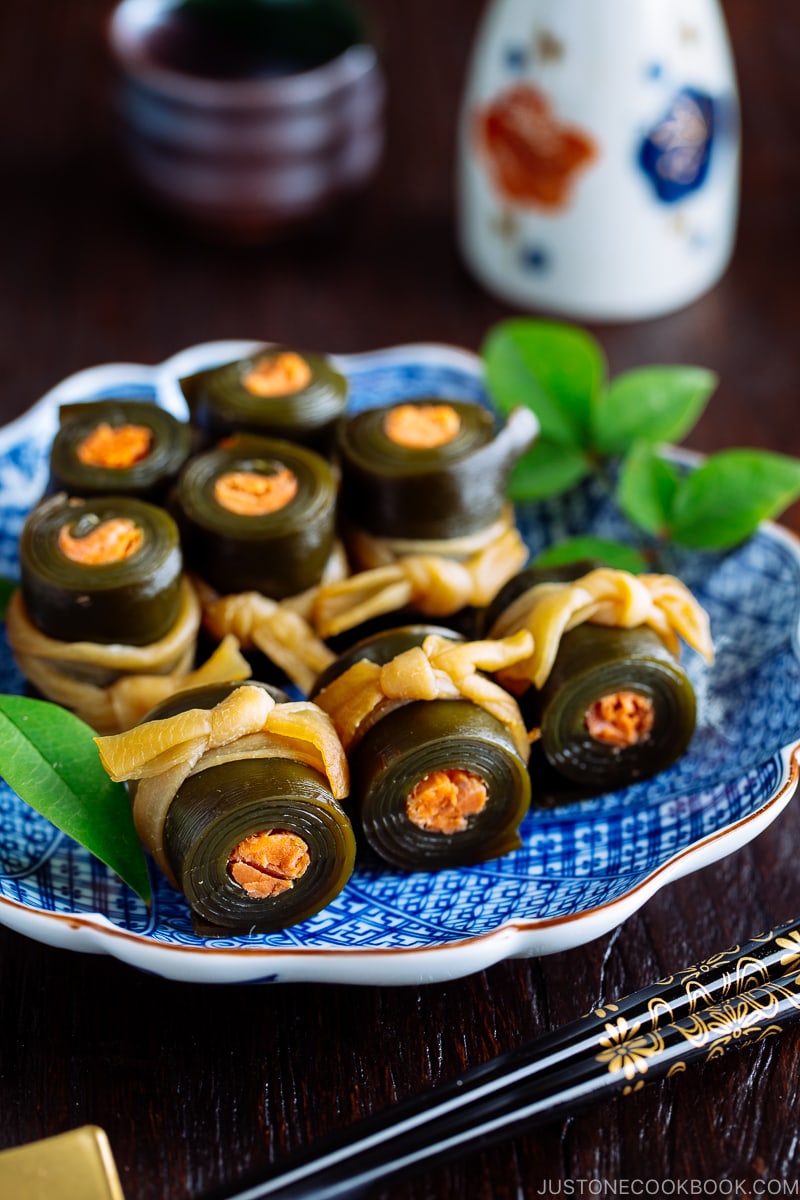
Key Ingredients for Salmon Kombu Roll
1. Hidaka Kombu
Japanese kombu is cultivated mostly in Hokkaido (北海道), the northernmost of Japan’s main island, and used quite extensively in Japanese cooking. Although much is not discussed, there are different types of kombu.
- Ma Kombu (真昆布)
- Rishiri Kombu (利尻昆布)
- Hidaka Kombu (日高昆布)
- Rausu Kombu (羅臼昆布)
Each kombu has slightly different flavors and textures. Ideally, it’s best to use specific kombu that is called for in each different recipe.
For this recipe, Hidaka Kombu works the best as it is tender, more flexible, and easy to fold up. They come in different widths and lengths, so don’t worry too much about making all the kombu rolls in equal size. Some may turn out to be longer, some fatter… they are all made out of love and that’s what makes them special.
2. Kanpyo (dried gourd)
Kanpyo is a Japanese ingredient that you don’t see very often in day-to-day Japanese foods. Typically used in traditional sushi recipes, you may have seen it in Futomaki (Thick Sushi Roll) and Chirashi Sushi. Over here, it is hydrated and used to tie around the middle of Kobumaki, which resembles the pattern of a kimono sash.
Kanpyo is a dried ingredient and can be found in the dried food section at your local Japanese grocery store. If you can’t find kanpyo, you can try using toothpicks or cooking twines to secure the rolls while cooking and then remove them before serving.
3. Salted Salmon (Shiozake / Shiojake)
You may wonder why we use salted salmon instead of raw salmon.
Since color plays an important role in the presentation for Osechi Ryori, the distinct pink of salted salmon makes the ideal choice to accent the kombu roll. Salted salmon releases less protein while simmering so it doesn’t make the broth or kombu rolls messy. It also has a less fishy taste and the flesh is much firmer for wrapping.
You can find salted salmon in Japanese grocery stores, so if you live near one, check out the store to save time from making your own Salted Salmon. Otherwise, you can make salted salmon on your own. I highly recommend making a big batch as they are so delicious and you can also make Salmon Fried Rice and Sanpeijiru (Salmon Soup) with the salted salmon.
If you decide to use raw salmon, use 2 tablespoons of sake to sprinkle over salmon to desalinate salted salmon. Sake removes and masks the fishy smell, and this might help a little bit. Do take note that regular cooked salmon will not work well in making kombu rolls as it may have albumin formation (white foam) which can ruin the appearance of the dish.
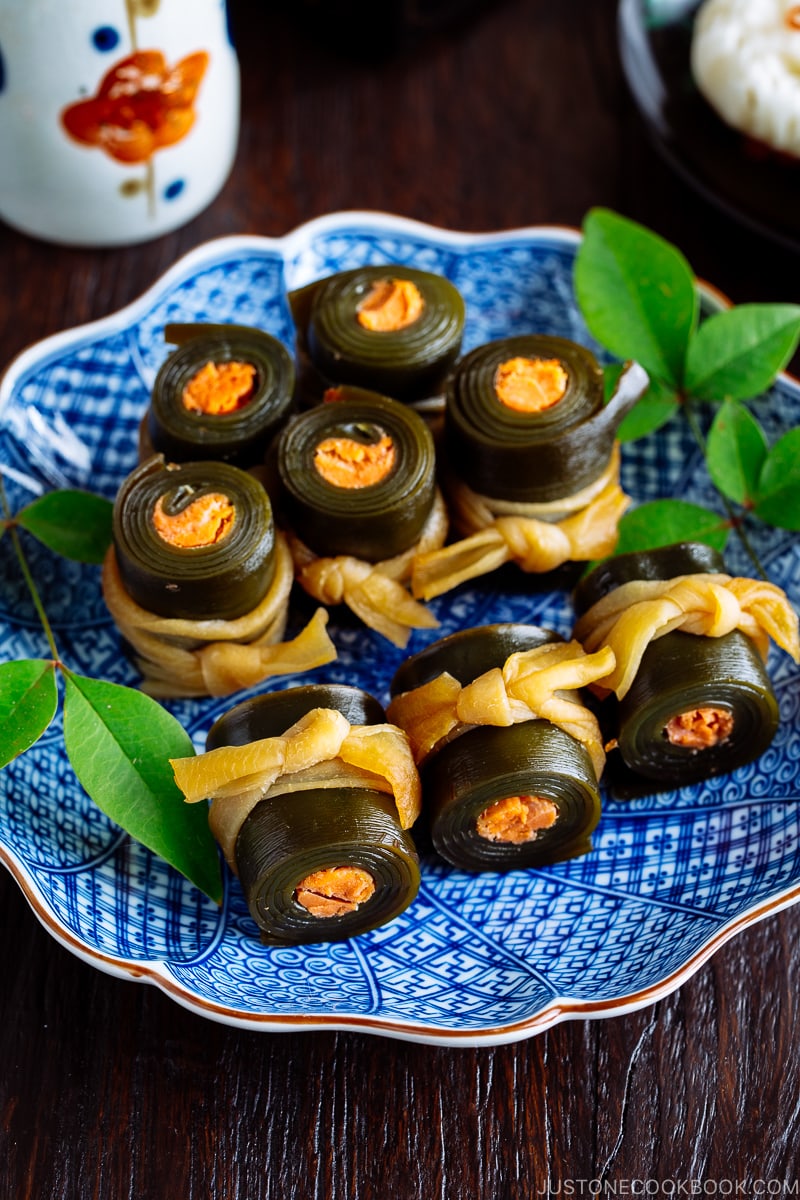
Skip the Salmon for Vegetarian/Vegan Kombu Roll
If you prefer a vegetarian/ vegan version, you can definitely do without the salmon and just roll up the kombu itself without any filling. In Osechi, Kobumaki 昆布巻きwith or without filling are both common and equally delicious.
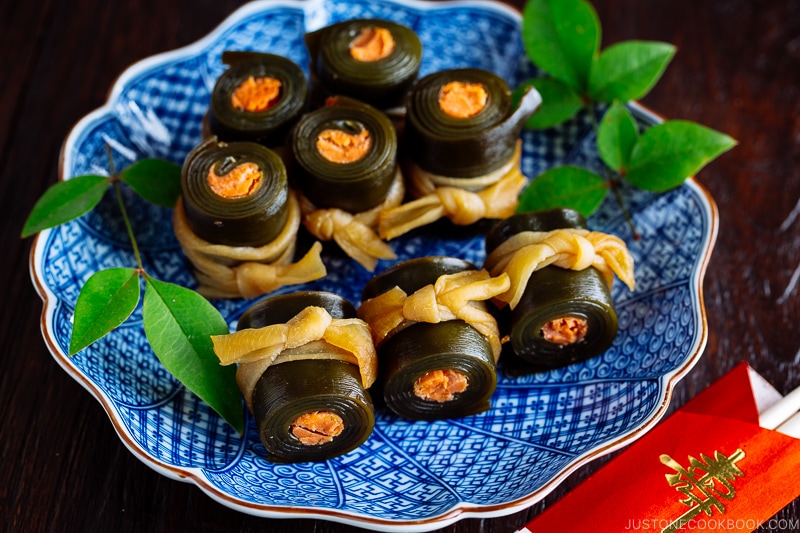
With an emphasis on beauty and fine details, these Salmon Kombu Rolls are the beautiful exemplification of traditional Japanese cuisine.
I hope you enjoy making this recipe. If you wish for more happiness in the coming year, follow the Japanese tradition, and eat more kombu dishes on New Year’s Day!
Wish to learn more about Japanese cooking? Sign up for our free newsletter to receive cooking tips & recipe updates! And stay in touch with me on Facebook, Pinterest, YouTube, and Instagram.

Salmon Kombu Roll
Ingredients
- 8 pieces hidaka kombu (日高昆布; known for its tender texture after rehydration)
- 5 cups water (for soaking the kombu)
- ½ oz dried kanpyo (gourd strips) (I used the whole package)
- 1 tsp Diamond Crystal kosher salt (for rubbing the kanpyo)
For the Salmon
- 2 cups water (for desalinating the salmon)
- 1 tsp Diamond Crystal kosher salt (for desalinating the salmon)
- 3 fillets Homemade Japanese Salted Salmon (you can purchase uncooked salted salmon at a Japanese grocery store or use my Salted Salmon recipe (uncooked); skip for vegan/vegetarian)
For the Seasonings
- ⅓ cup sake
- 1 tsp rice vinegar (unseasoned)
- 3 Tbsp sugar
- 3 Tbsp soy sauce (divided)
- 3 Tbsp mirin
Instructions
- Before You Start: If you will include this dish in your Osechi meal, I recommend cooking it up to a day before you plan to serve. For more helpful tips on planning your Japanese New Year feast, please read my A 5-Day Osechi Cooking Timeline blog post.
- Gather all the ingredients.

- Soak 8 pieces hidaka kombu in 5 cups water for 30 minutes. Reserve this liquid called kombu stock (or Kombu Dashi), yielding roughly 4 cups, for cooking the rolls later.

- Soak ½ oz dried kanpyo (gourd strips) in water for 15 minutes and drain. Quickly rinse the kanpyo under running water and rub it with 1 tsp Diamond Crystal kosher salt. Rinse again and drain well.

To Prepare the Salmon
- In a flat container, add 2 cups water and 1 tsp Diamond Crystal kosher salt for the salmon. Then, place 3 fillets Homemade Japanese Salted Salmon (uncooked) in the container and set them aside for 30 minutes to desalinate. Tip: Why do we use salted salmon? It releases less protein while simmering compared to regular salmon.

- Remove the salmon from the salted water and gently pat dry with a paper towel.

- Using a sharp knife, remove the bones from your fillets, if there are any.

- If you have kitchen tweezers, use them to easily remove any individual bones from the flesh. Finally, use the knife to remove the skin.

- Cut the salmon fillets into a log shape about the same width as the kombu, roughly 3½ x ¾ inches (or any shape that is easy to roll up in the kombu). Make sure the salmon and kombu are the same width.

To Roll
- Wipe off the excess moisture from the kombu with a paper towel.

- Place the log-shaped salmon at one end of the kombu and start rolling it up. As you roll tightly, pull up the other end of the kombu a few times to maintain the tension.

- Once you finish rolling the salmon in the kombu, secure the roll with the kanpyo tied in a knot. Depending on the width of the kombu, you might need to tie the roll in one to three spots. Think about the final serving size and decide on the location of the knots. Here, I tied each roll in two spots. Since I will cut each roll in half, one strip of kombu makes two pieces. Repeat with the remaining salmon and kombu.

To Cook
- Place the salmon kombu rolls in a large pot (I use a Le Creuset 3.5 QT pot). Add enough of the reserved kombu dashi to fully submerge the rolls; I used roughly 3 cups. You don’t have to use all of the kombu dashi. Save the remainder just in case you need to add more liquid later.

- Add ⅓ cup sake and 1 tsp rice vinegar (unseasoned) to the pot.

- Place an otoshibuta (drop lid—see how we can make it with aluminum foil) on the rolls. We do not use a regular pot lid throughout the cooking process. Once boiling, skim off the foam and scum on the surface. Then, cook on a gentle simmer for 1 hour. If the cooking liquid evaporates too fast, add the reserved kombu dashi (I did not need to add more stock).

- Insert a wooden skewer to check if the kombu has become tender.

- Once it’s tender, add 3 Tbsp sugar and half of the 3 Tbsp soy sauce.

- Instead of stirring with utensils that can potentially break down the kombu, hold the pot and swirl it around to mix the seasonings and coat the food. Simmer with the otoshibuta in place for 15 minutes.

- Add 3 Tbsp mirin and the rest of the soy sauce. Simmer with the otoshibuta in place for another 10 minutes, or until the cooking liquid is almost gone. Once it’s done cooking, remove from the heat and let cool.

- Once cool enough to handle, cut the kombu in half (if you have 2 ties). If you‘d like, cut off both ends for a neat and tidy presentation.

To Serve and Store
- Serve at room temperature in Osechi Ryori. Store in the refrigerator for up to 7–10 days; you can also freeze the Salmon Kombu Rolls for up to a month.
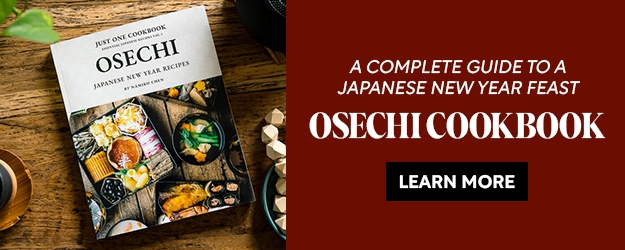
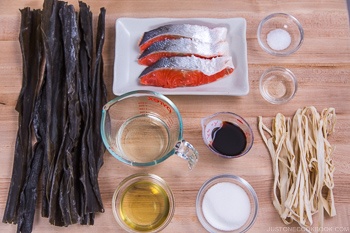
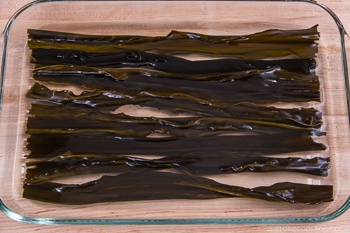

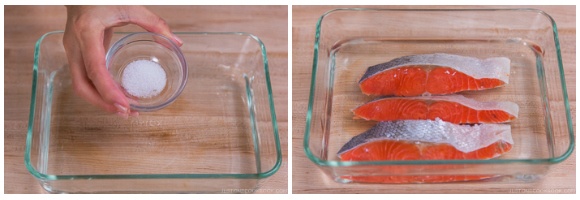
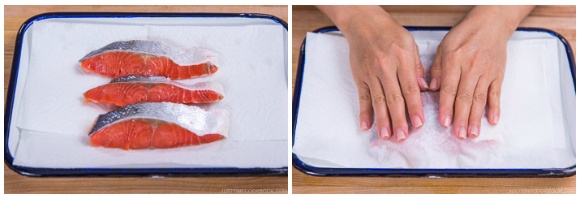

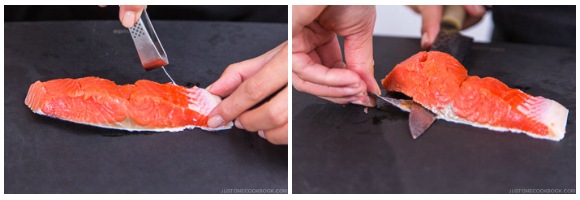
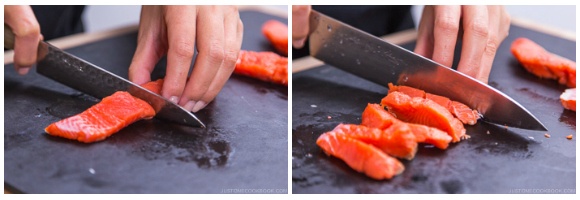
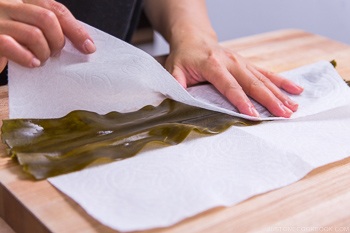

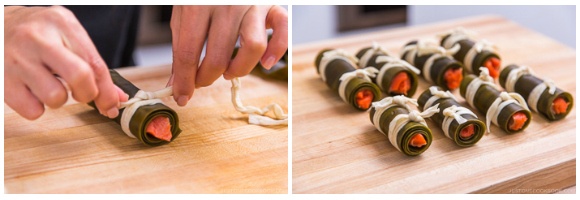

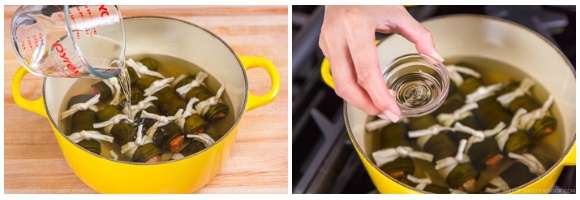
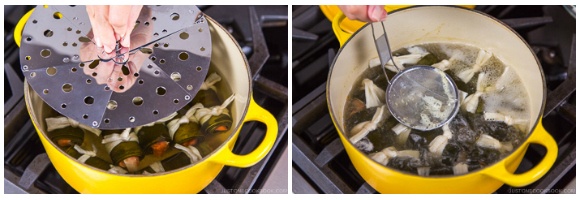
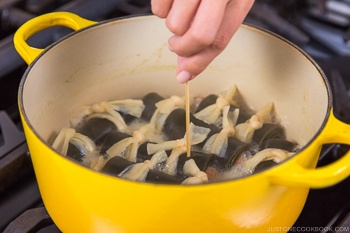

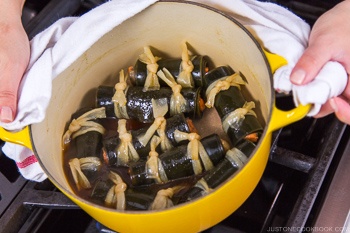
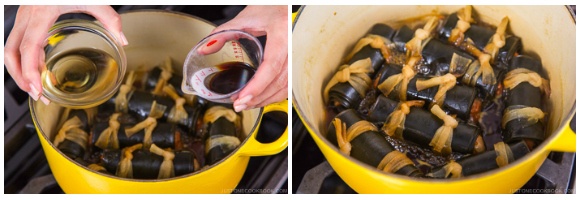
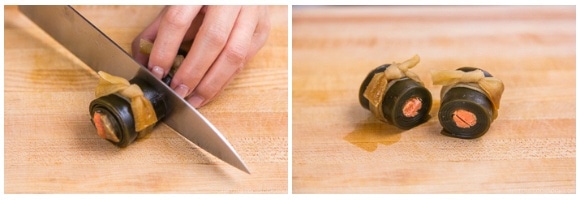










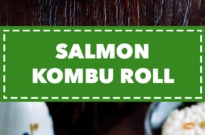
[…] scattered on top of chirashi sushi. It’s also used as an edible string to bind foods, such as kombu rolls and mochi kinchaku (deep-fried tofu skins stuffed with […]
Hello Nami!
This is one of my favorite recipes to make and every time I make it I always have a lot of cooking liquid left! You mention that the cooking liquid should be almost gone by the end of the simmering time so I’m wondering what I am doing wrong?
Is it also possible to re-use the leftover cooking liquid for something else after like a sauce or marinade? I always feel like it is such a waste to dump it all away…
Thank you for such an amazing recipe!
Hi Tiffany, Thank you very much for trying Nami’s recipe and for your kind words!
The best way to cook this Salmon Kombu roll is to use Otoshibuta at Step 18. Otoshibuta: https://www.justonecookbook.com/how-to-make-otoshi-buta/
The Otoshibuta ensures that the heat is evenly distributed, allowing the ingredients to cook quickly and evenly as they absorb all the delicious flavors. The cooking liquid wouldn’t be much left.
To re-use the leftover cooking liquid, you can use it for simmering the other type of vegetables like carrot, potato, gobo, spinach, etc.
We hope this helps!
Hi Nami!
I made this recipe and it turned out very salty. Do you think that it could have been from the Kombu I used? Or maybe I did not de-salt the salmon enough? After submerging the Kombu rolls in water for a bit, the taste was much better!
Hi Rene,
Thank you very much for trying this recipe.
A few things we want to check with you…
1) Did you make the salted salmon or buy it from the store. Japanese salted salmon is very salty for people who never tried it before because we always eat it with plain rice. So it’s possible that your salmon needed to de-salt more.
2) What kind of kombu you used? Even though kombu is from the ocean, it’s not really salty and only contains umami. So I highly doubt that it’s the kombu that has an issue; unless you used different types of kombu.
3) Seasoning should not make this dish salty; however, a type of soy sauce does matter. For example, DO NOT use tamari soy sauce. It’s stronger, and it’s not as thin. What type of soy sauce did you use?
4) It’s possible that it’s a personal preference, too. Osechi dishes are supposed to last for several days, and it’s meant to be (super) sweet, salty, and sour for the purpose of food preservation. However, Nami did not make this dish extremely salty as she also makes it for a regular occasion, not for Osechi’s purpose.
Hope this helps! We’re happy to help with any questions you may have. We are glad you made it less-salty by rinsing it but hope you can make it better next time without doing so.
I was wondering if the salted salmon you refer to is the one you have in this recipe (https://www.justonecookbook.com/how-to-cook-salmon-salted-salmon/) or something else.
Thank you!
Hi Kanmuri,
Yes! You may use the recipe for the salted salmon. (We added the link to the recipe card.)
Thank you for trying this recipe!🙂
[…] Suitable Dishes: Dashi, simmered dishes (nimono), non-clear soups, and kombu rolls like Salmon Kombu Rolls. […]
Nami! I am making this recipe for my first time this year. I already know it is delicious from eating the parts I trimmed off the edges. Wow! Oishii. :9
I want to ask, how should they be stored in the fridge? Just put it into an airtight container? Would they store well in the rest of the cooking liquid to maintain more flavor, or would that just make them gooey and soggy? For now, I put mine into a glass food storage container (with airtight plastic lid) and I put a piece of cling wrap directly over the rolls inside to try to keep moisture in them.
Also, my best tip for anyone new to this recipe: The kanpyo gets very soft after cooking! Be careful removing and cutting the rolls. I had a few fall apart in the process because the kanpyo broke (one stuck to the pan for some reason, the other I accidentally hit with the edge of the otoshibuta).
Hi Lion! I apologize I couldn’t respond to you sooner. Yes, you need to put it in an airtight container. The cooking liquid should be almost gone by the time you’re done with cooking and since the kombu has good flavor, you do not need to keep the liquid. However, you can keep some liquid and brush off before presenting as well (just option). 🙂
And thanks so much for sharing your tip with us!
[…] Salmon Kombu Roll […]
Would using kombu that has been used to cook dashi greatly affect the taste of this dish? Most people seem to discard the kombu after cooking dashi, but it feels pretty wasteful to me. This recipe seems like the answer to reducing kombu waste!
Hi Qlevi! Ah I get your point, but not for this recipe, as we need that kombu dashi flavor from kombu FOR THIS RECIPE. 🙂
I make furikake (rice seasonings) with leftover katsuobushi and kombu. https://www.justonecookbook.com/homemade-furikake-rice-seasoning/ 🙂